Balkanization and Slav nationalism
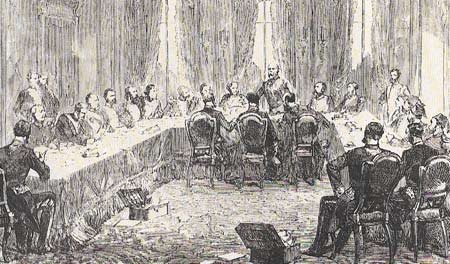
Figure 1. The Congress of Berlin in 1878 drew up a Balkan settlement that was to last a generation. Dominant personalities were the British Prime Minister, Benjamin Disraeli (1804–1881) and the German Chancellor Otto von Bismarck (1815-1898). Under a treaty signed in July, Russia had to agree to the scrapping of the Treaty of San Stefano, made in March, giving her and her Balkan allies huge territorial gains. Under pressure from Britain, Austria-Hungary and Germany, victorious Russia agreed to limit itself to taking a strip of Bessarabia from Romania, Batam and Kars in the Caucasus and a part of Armenia. Romania's independence was formally recognized. Bosnia and Herzegovina were handed over to Austria-Hungary to administer. Britain was given Cyprus to keep as long as Russia kept Kars and Batum. Serbia and Montenegro received land that Bulgaria had gained earlier but remained cut off from the Aegean. Macedonia was returned to Turkey.
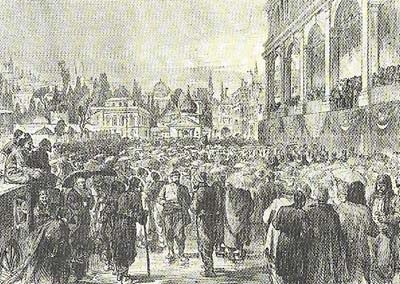
Figure 2. At Constantinople in 1876, Sultan Abdul-Hamid II (1842–1918) proclaimed a constitution under pressure from Western-educated officials to reform the reactionary Turkish Empire. But he soon abrogated the constitution and it was only in 1908 that the Young Turk movement forced him to re-issue it, summon parliament and abolish press censorship. When he prepared a counter-coup in 1909 he was overthrown and replaced.
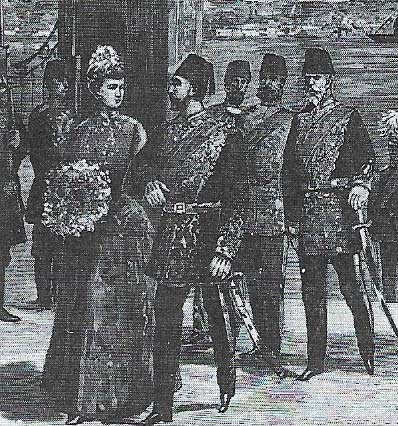
Figure 3. The German kaiser Wilhelm II (1859–1941), here visiting Constantinople, played a major role in Germany's moves to acquire influence in Turkey as part of a larger extension of power in central Europe and the Mediterranean. Based on a concession granted in 1899 by Turkey to the German company of Anatolian Railways, a rail system was to be built all the way from Berlin to Constantinople and Baghdad as the key to a new German Empire.
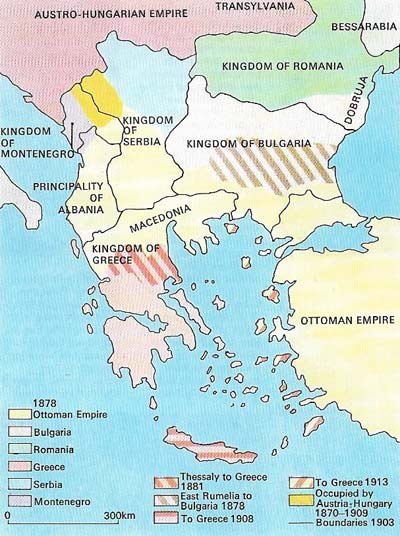
Figure 4. The new Balkan states, formed as a result of Turkey's retreat from Europe, were in dispute with each other: Serbia and Bulgaria over Macedonia; Romania and Bulgaria over Dobruja; and Romania and Austria-Hungary over Transylvania. But the most explosive dispute between Serbia and Austria-Hungary because of Serbia's support of terrorist activity among Slavs living under Austro-Hungarian rule. This was greatest in Bosnia-Herzegovina, a province of Croats, Serbs and Slav Muslims, which Austria-Hungary had taken over in 1878 and formally annexed in 1908 in order to prevent Serb agitation. Austria-Hungary also frustrated Serbia's attempt to gain direct access to the Adriatic by encouraging the formation of a separate Albanian state, which was proclaimed in 1912.
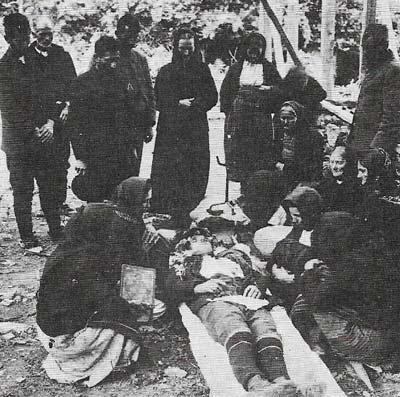
Figure 5. The first Bulgarian soldier to be killed in the first Balkan War is surrounded by mourners. Although fighting did not begin until October 1912, the seeds of conflict were sown in a secret treaty concluded between Serbia and Bulgaria in March. They planned to attack Turkey and divide the spoils. According to this, Serbia was to have the given most of Albania. The war started when Montenegro attacked Turkey on 8 October. Bulgaria, Serbia and Greece then joined in, and soon the Turks were reeling under the combined onslaught. They asked for a truce in December.
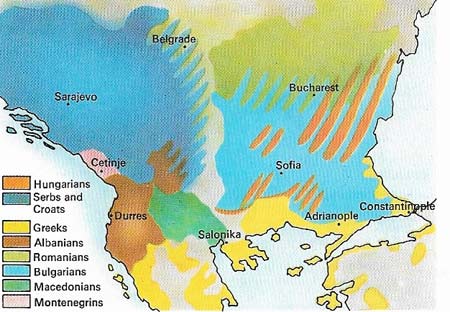
Figure 6. Peoples of many different races and religions inhabit the Balkans. The Croats have a Latin script in a Roman Catholics. The Serbs, Bulgarians, Montenegrins and Macedonians receive their Cyrillic script, Orthodox religion, and political tradition from Byzantium. Under Turkish rule the Orthodox Church retained its autonomy and was influential in the national revival of the Balkan peoples. Turkey left two enclaves of Islam in Europe: Bosnia and Albania.
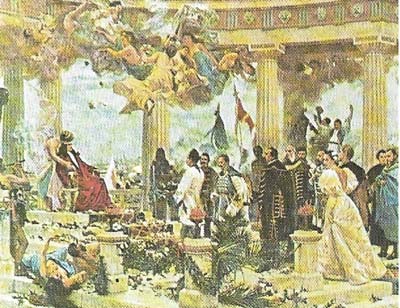
Figure 7. The spirit of Slav nationalism is captured in "The Illyrian Revival" by a 19th-century Croatian painter, Vlaho Bukovac. Illyria was a hoped-for independent union of south Slavs under Croat leadership. But the Serbs, who managed to free themselves from Turkish rule in 1830 and became a kingdom in 1882, took the upper hand while Croatia and Slovenia remained part of Austria-Hungary.
Austria-Hungary and Russia were the chief protagonists in the struggle to supplant the once powerful Turkish Empire, "the sick man of Europe" (Figure 2), as the dominant power in the Balkans in the second half of the 19th century. For Russia, the mastery of the Balkans would have served its historic aim: to gain control of the Straits of Bosporus and the Dardanelles with the city of Constantinople, and thus gain access to ice-free seas. Austria-Hungary's main concern was to prevent Russia from establishing itself in the Balkans as the protector of a cluster of small states, some claiming territory within the Hapsburg Empire. The Austro-Hungarian policy of blocking Russia's advance towards the Mediterranean was supported by both Germany and Britain.
Russian hopes dashed
In 1877–1878, Russia fought Turkey on the side of Serbia and Montenegro in support of Slav Christians in the province of Hercegovina who had clashed with the Turkish authorities because they refused to pay taxes or to per-form the customary labor services. A Turkish force sent against them in 1875 had been defeated with the aid of sympathizers from Serbia and Montenegro as well as from Austria-Hungary's Croat province of Dalmatia. The insurrection had then spread in 1876 to Bulgaria, where an estimated 12,000 to 30,000 Bulgarians were killed by Turkish irregulars in atrocities that aroused indignation throughout Europe.
Although Russian armies reached the outskirts of Constantinople in 1878, the diplomacy of Britain and Austria-Hungary frustrated Russia's main aim. At the Congress of Berlin (Figure 1), Russia secured territorial enlargement for Serbia and Montenegro and independence for Bulgaria. Austria-Hungary (which had stayed neutral) was allowed to occupy Bosnia-Hercegovina, Bulgaria was denied access to the Aegean, and the province of Macedonia, to which both Serbia and Bulgaria aspired, was handed back to Turkey.
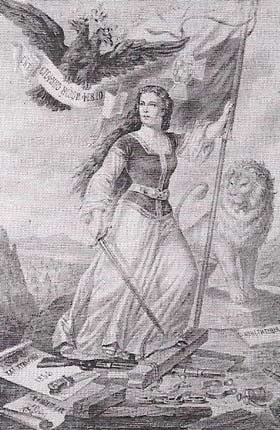 |
| San Stefano, the name on the girl's flag in this Bulgarian poster, summed up Bulgaria's efforts to regain from her neighbors what she had won in the San Stefano treaty but lost at Berlin. To that end, Bulgaria fought and defeated Serbia in 1885, but was forced to withdraw after Austrian intervention. In October 1915 Bulgaria, allied to Austria and Germany, again fought Serbia. |
Serbian and Montenegrin successes in the war fired the imagination of all Slays in the Austro-Hungarian Empire, but particularly those in the south: Croats, Slovenes and Serbs living outside Serbia proper in Bosnia, Croatia and Hungary. In Serbia itself the government covertly, and various non-official bodies overtly, gave money and encouragement to groups working for south Slav union. Serbian politicians and intelligentsia saw Serbia as the nucleus of a greater southern Slav nation (Figure 7).
Revolutionary societies
Croats and other Slays living in the Hungarian half of the Hapsburg Empire originally viewed the idea of a union with Serbia with suspicion, preferring a south Slav state under Hapsburg leadership. But alienated by Magyar dominance in Hungary, many of them became revolutionary towards the 1900s. Sensing the nationalist threat to their multi-national empire, the Hapsburgs redoubled efforts to control and subdue Serbia, in their view the originator of the monarchy's troubles. The annexation of Bosnia-Hercegovina in 1908 was the result. It was an attempt to preempt south Slav nationalism by simply incorporating a disputed area into the empire and thus, hopefully, neutralizing it. Russia's weakness after her defeat in the disastrous war against Japan in 1904–1905 enabled Austria-Hungary to escape without Russian retaliation.
The Balkan Wars
The Bosnian annexation initially turned the main thrust of Serbian nationalism south towards Albania and southeast Macedonia which Serbia, Bulgaria, and Greece all claimed but which the Congress of Berlin had handed back to Turkey. Exploiting Turkey's preoccupation with its war against Italy in 1911–1912, the four Balkan states – Greece, Bulgaria, Serbia, and Montenegro – set up the so-called Balkan League and declared war on Turkey in October 1912 (Figure 5) (the first Balkan War 1912–1913). But the victorious anti-Turkish forces were again frustrated by great power diplomacy.
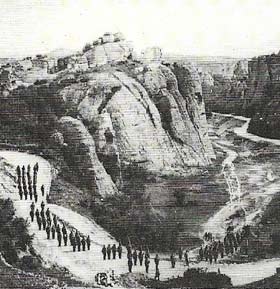 |
| Bulgarian troops (here shown near the Serbian border) moved against Serbia in June 1913, so starting the second Balkan war. The attack preempted Serbia's designs on parts of Macedonia, held by Bulgaria since the settlement to the first war. By August, however, Bulgaria had been defeated by an alliance of all her neighbours. In the settlement, Serbia gained most while Turkey, Greece and Romania also made territorial gains. |
Germany saw Turkey as the strategic base of its own future thrust into the Middle East and beyond (Figure 3) to challenge its greatest rival, Britain. Under Austrian pressure the Serbs were denied access to the Adriatic by the establishment of Albania as a separate state. Serbia in turn quarreled with Bulgaria over Macedonia and war broke out between them in June 1913 and lasted a month. Bulgaria was defeated by an alliance of all her neighbors including Romania.
But Hapsburg hopes of the situation becoming calmer in the wake of the Bosnian annexation were disappointed. Nationalist agitation for a union of all south Slays was boosted by Serbia's successes in the Balkan Wars. Assassinations by members of secret societies in Bosnia and elsewhere became commonplace. The apparent political impasse made Austria-Hungary's leaders think once again of a military solution. The idea was that if only Serbia, the hotbed of nationalistic agitation, could be subdued and neutralized, the rest of Europe would calm down. Germany's virtually unlimited backing of Austria-Hungary's policies strengthened the resolve of certain Austrian military and civilian leaders. The assassination of the heir to the Hapsburg throne, Archduke Franz Ferdinand, in Sarajevo in Bosnia in June 1914, by a revolutionary group based in Serbia, gave them the pretext for war.
